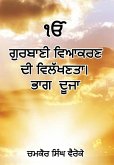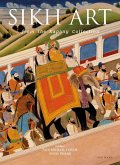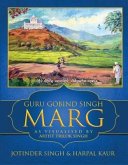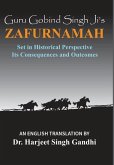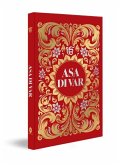Uniqueness of Gurbani Grammar Volume I Gurbani-the sacred scriptural writings of Sikhism-was composed during a time when the Punjabi language was still in its developing stages. Though the script used is Gurmukhi, rooted in Punjabi phonetics, the language of Gurbani itself is a combination of many languages and dialects. It was written at a time when grammatical elements such as prepositions, nouns, pronouns, adjectives, adverbs, participles, and verbs were understood through vowel symbols (lagaan maatraaṇ). Even gender, number and tense were communicated through these vowel markers which is why it is referred to as a conjunctive language. Over time, Punjabi has evolved into a fully matured and structured language whereby all connectors are distinct, sounds have changed significantly under the influence of neighboring languages. Nouns, gender, number, adjectives, adverbs, and verbs-all of these have changed. This transformation allows modern Punjabi to be referred to as a differentiated or disjunctive language. As with any language, understanding Gurbani requires understanding its rules-its grammar. No script, no matter how ancient or divine, can be grasped without an understanding of grammar within the language. Even Sanskrit remained locked in mystery until Rishi Vyasa codified its grammar, which provided an understanding of the Rigveda. The same principle applies to Gurbani. To unlock its meaning, one must first read it, then learn its grammar, and only then begin to understand it. Grammar, in this context, is not academic for the sake of academia-it is a sacred tool, a bridge between divine expression and human comprehension. Gurbani grammar is solely intended to help understand Gurbani. Each person must apply its teachings to their own life. To truly understand Gurbani, a step-by-step approach is essential: Letter recognition (ਅੱਖਰ ਗਿਆਨ) - learning the script and pronunciation. Word-level understanding (ਪਦ ਗਿਆਨ) - grasping individual words. Sentence-level understanding (ਵਾਕ ਗਿਆਨ) - understanding structure and syntax. Shabad-level insight - interpreting complete hymns. Poetic understanding - appreciating the literary and metaphorical beauty. Knowing the letters helps with pronunciation of words and understanding where to pause in a sentence-these are fundamentals to grasping Gurbani. Once we have understood these steps, it is necessary to understand the literal meanings of words, phrases, and complete expressions. However, in order to apply the interpretive meaning to our daily lives which is the whole purpose of Gurbani, it is essential to grasp the contextual or deeper meanings of words. Although every Sikh prays at the Guru's court for correct pronunciation of Gurbani, very few make the efforts to truly learn, understand, and know its meaning. Despite its pivotal and crucial role in helping us decipher the intended messages, the study of Gurbani grammar has consistently been regarded as an afterthought. It wasn't until the 1930's -centuries after Guru Nanak composed his first compositions - that Sikh thinkers acknowledged the existence of grammar within Gurbani. It is the efforts of Principal Teja Singh, Professor Sahib Singh, Pandit Kartar Singh Dakha, and Joginder Singh Talwara that made significant contributions to this field that remain the cornerstone of Gurbani grammar today. Chamkaur Singh Vairoke.
Bitte wählen Sie Ihr Anliegen aus.
Rechnungen
Retourenschein anfordern
Bestellstatus
Storno


